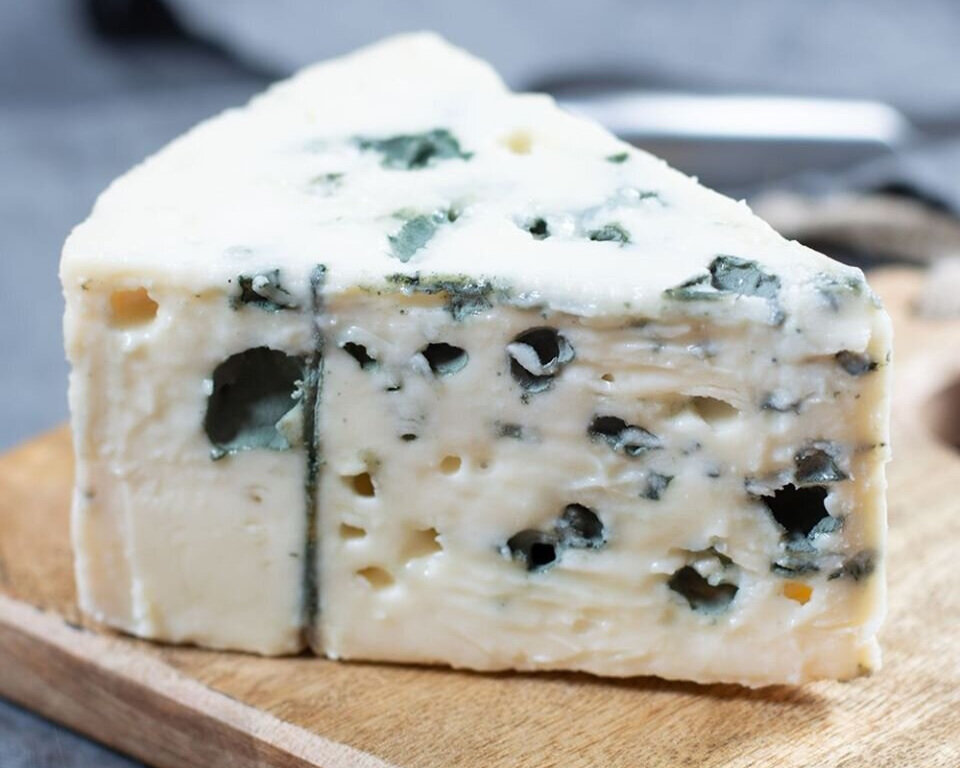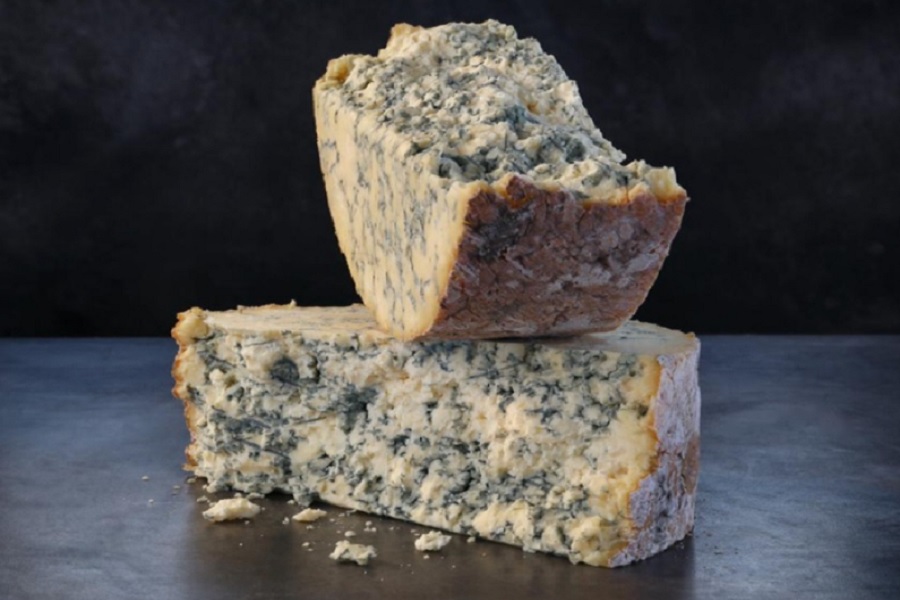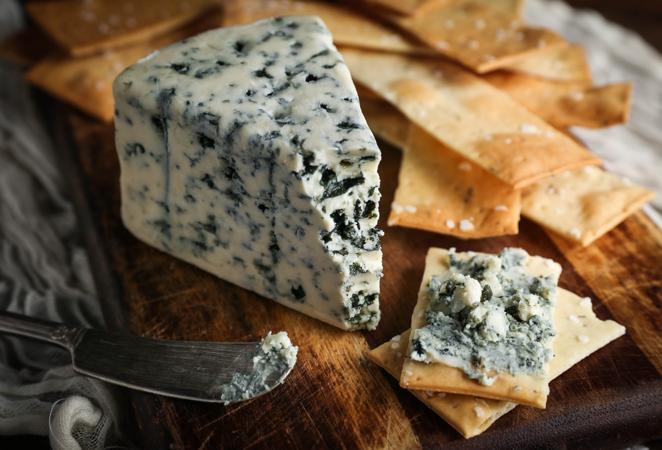The Art of Blue Vein Cheese: A Journey Through Flavor and Texture

Blue-veined cheese, often associated with strong flavors and a distinctive aroma, is a marvel of culinary sophistication.
It’s a testament to the skill and patience of cheesemakers who have mastered the art of introducing cultures of the mold Penicillium into their creations, resulting in an intricate network of blue or green veins – the trademark of this iconic cheese.
But how did these cheeses come to be? How are they made, and what gives each one its unique character? Why do some people love them while others are more hesitant?
Join us as we embark on a journey through time and across continents, exploring the art of blue-veined cheese.
Quick Facts About Blue Cheese
| Fact | Description |
|---|---|
| Origin | Different types of blue cheese have different origins, including Italy (Gorgonzola), France (Roquefort), and England (Stilton) |
| Milk Source | Depends on the type of blue cheese, but can be made from cow’s, sheep’s, or goat’s milk |
| Texture | Can range from crumbly to creamy, depending on the specific type of blue cheese |
| Flavor | Strong, tangy, and pungent with a notable ‘blue’ or moldy flavor |
| Color | Generally white or cream-colored cheese with distinctive blue or blue-green veins of mold |
| Aging Process | Typically aged for at least 3-4 months, but some types are aged for a year or more |
| Protected Designation of Origin | Some types of blue cheese, such as Roquefort, Gorgonzola, and Stilton, have PDO status in the European Union |
| Historical Origins | The creation of blue cheese dates back to ancient times, with Roquefort mentioned in texts as early as 79 AD |
| Uses | Used in salads, dressings, dips, pasta dishes, or served with fruit and wine |
What is Blue Cheese?
Blue cheese is a type of cheese that is known for its characteristic blue or blue-green veins and spots, which are created by cultivating the cheese with molds. The most common mold used is Penicillium roqueforti, giving the cheese its distinctive flavor and smell.
Blue cheese can be made from cow, sheep, or goat’s milk and it has a strong, tangy flavor and crumbly texture. It’s often aged for several months to enhance its taste and aroma.
There are many different types of blue cheese, some of the most popular include Roquefort (from France), Gorgonzola (from Italy), and Stilton (from England). Each type varies in flavor, texture, and sharpness, depending on the specific recipe used and the length of aging.
Blue cheese is commonly used in salads, pasta dishes, dips, and sauces. It can also be enjoyed on its own, often paired with fruits like pears, apples, or figs, or with a glass of bold red wine or sweet dessert wine.
Also read: 12 Most Popular Blue Cheeses in the World
What is the blue vein in cheese?
The blue vein in cheese is a result of the introduction of Penicillium cultures, a type of mold, during the cheesemaking process.
These cultures are responsible for the distinctive blue or green veins that can be seen in varieties like Blue Stilton, Gorgonzola, and Roquefort.
Here’s how it works: After the initial curdling process, the cheesemaker pierces the cheese with stainless steel rods, which allows air into the product. The introduced air then enables the Penicillium cultures to grow, resulting in the characteristic blue veins.
Also read: The Science of Cheesemaking: A Journey from Milk to Artisanal Delight
These molds not only give the cheese its striking appearance but also contribute to its unique flavor and aroma. The veins produce enzymes that break down proteins and fats in the cheese, leading to a complex mix of flavors often described as tangy, spicy, or even pungent.
So, while the blue veins might look intimidating to some, they’re actually a sign of a carefully crafted and flavorful cheese.
Is blue-veined cheese good for you?
Blue-veined cheese, like many other types of cheese, can be part of a healthy diet when consumed in moderation.
1. Nutritional Benefits:
Blue cheese is a good source of protein, providing essential amino acids necessary for bodily functions. It’s also rich in calcium, which is vital for bone health. Additionally, it provides other nutrients like vitamin A, vitamin B2 (riboflavin), and minerals such as zinc and phosphorus.
2. Probiotic Properties:
The Penicillium mold used in blue cheese is a type of probiotic, which is beneficial for gut health. Probiotics help maintain a healthy balance of bacteria in the gut, aid digestion, and can boost the immune system.
3. Satiety:
The high protein and fat content in blue cheese can help you feel satiated, potentially aiding in weight management by reducing overall calorie intake.
However, it’s important to note that blue cheese is also high in saturated fats and sodium, which can contribute to health issues like heart disease and high blood pressure when consumed excessively. People with a specific allergy to mold or penicillin should also avoid blue cheese.
As always, if you have specific dietary concerns or health conditions, it’s best to consult with a healthcare professional or a registered dietitian before making significant changes to your diet.
Blue cheese nutrition facts
The key nutrients in a 100 grams serving of Blue cheese:
| Nutrient | Quantity |
|---|---|
| Protein | 21.40g |
| Total Fat | 28.74g |
| Saturated Fat | 18.669g |
| Cholesterol | 75mg |
| Sodium | 1,395mg |
| Potassium | 256mg |
| Total Carbohydrate | 2.34g |
| Dietary Fiber | 0g |
| Sugars | 0.50g |
| Calcium | 528mg |
| Vitamin A | 198 IU |
The Calories in Blue Cheese
100 grams of blue cheese contain approximately 353 calories.
A 1-ounce serving (28 grams) of blue cheese typically contains around 100 calories, with a breakdown of 72-73% fat, 3% carbs, and 24% protein.
If you’re considering a smaller portion, a 1-inch cube (around 0.6 oz) of blue cheese contains about 60 calories.
What Does Blue Vein Cheese Taste Like?
Blue-veined cheese is known for its bold and complex flavor profile. The taste can vary significantly depending on the specific variety of cheese and how long it has been aged, but there are some common characteristics that many blue cheeses share.
| Characteristic | Description |
|---|---|
| Strong and Pungent | Blue cheeses are renowned for their intensity. They often have a strong, pungent aroma and a flavor that can be described as sharp or robust. |
| Salty and Spicy | Many blue cheeses have a distinct salty taste, which can be balanced by a slight sweetness in some types. Some people also describe the flavor as slightly spicy, not in terms of heat, but resembling the bite of black pepper or a hint of spiciness that tickles the back of your throat. |
| Creamy and Crumbly | The texture of blue cheese can influence its taste. Some blue cheeses like Gorgonzola can be incredibly creamy and rich, which can mellow out the intense flavor. Others, like Stilton, can be more crumbly, which pairs well with the strong, complex flavors. |
| Funky and Earthy | The blue veins in the cheese contribute to a unique, earthy taste – some describe it as ‘funky’ – that is distinctive to blue cheese. This can add depth and complexity to the cheese’s overall flavor profile. |
Don’t hesitate to try different varieties to find the one that suits your palate the best.
What are the 4 types of Blue Cheese?
1. Roquefort:

Originating from France, Roquefort is made from sheep’s milk and is known for its creamy texture and sharp, tangy flavor. It has a moist and crumbly texture with a strong aroma.
2. Gorgonzola:

This Italian blue cheese can be spicy or sweet, depending on its age. Young Gorgonzola (Gorgonzola Dolce) is softer and creamier with a mild flavor, while aged Gorgonzola (Gorgonzola Piccante) has a firmer texture and a more intense, spicy taste.
3. Stilton:

Often referred to as the “King of Cheeses” in England, Stilton is creamy and crumbly with a bold, rich flavor. It’s less salty than some other blue cheeses and has a distinctive nutty and slightly sweet taste.
4. Danish Blue:

Also known as Danablu, this cheese from Denmark is creamy and semi-soft, with a mild, slightly salty flavor. It’s less intense than some other blue cheeses, making it a good introduction to the category.
These are just a few examples of blue cheese. There are many other varieties out there, each with its own unique qualities.
The Unique Flavor and Texture of Blue Vein Cheese
| Blue Vein Cheese | Flavor | Texture |
|---|---|---|
| Roquefort | Strong, tangy, salty | Crumbly and moist |
| Stilton | Rich, mellow, slightly sweet | Crumbly, yet creamy |
| Gorgonzola | Mild to sharp, depending on age | Creamy to crumbly, depending on age |
| Danish Blue | Mild, slightly tangy and salty | Semi-soft, creamy |
| Bleu d’Auvergne | Spicy, salty | Creamy, moist |
| Fourme d’Ambert | Mild, fruity | Creamy, firm |
Note: the flavor and texture can vary based on the age and specific production process of the cheese.
Is blue Vein Cheese a Form of Probiotic?
Yes, blue cheese can be considered a source of probiotics. Probiotics are beneficial bacteria that promote a healthy gut.
The blue veins in this type of cheese are a result of cultures of the mold Penicillium being added, which are types of fungi. During the aging process, these added cultures grow and proliferate, leading to the characteristic blue or blue-green veins. These molds, particularly Penicillium roqueforti and Penicillium glaucum used in making blue cheese, have been found to have probiotic attributes.
It’s important to note that while blue cheese does contain probiotics, the concentration can vary based on factors like the specific production process and how the cheese is stored.
Also, those with a weakened immune system or certain health conditions should consult with their healthcare provider before consuming foods with mold, even beneficial kinds.
Is blue Vein Cheese Mouldy?
Yes, blue vein cheese such as blue cheese is essentially “moldy” – but in a good way.
The blue veins in the cheese are a result of cultures of the mold Penicillium being added during the cheese-making process. This mold, particularly Penicillium roqueforti, is used to give the cheese its characteristic flavor and appearance.
The molds used in making blue cheese are safe to eat. However, it’s important to differentiate between the intentional, edible molds in blue cheese and harmful molds that can occur on spoiled food. Blue cheese should be discarded if there are any changes in its appearance or smell that suggest spoilage.
So, while it is technically correct to say that blue vein cheese is “moldy,” it’s also important to understand that these molds are not only safe to eat (in most cases) but are also what give the cheese its unique and beloved flavor.
Is blue Vein a Hard Cheese?
Blue vein cheese is generally not classified as a hard cheese. It typically has a semi-soft to soft texture, depending on the specific type and how long it has been aged.
Why Do So Many People Love Blue Cheese?
Here are a few reasons why many people love blue cheese:
- Unique Flavor: Blue cheese has a distinct and robust flavor that sets it apart from many other types of cheese. It’s known for its strong, tangy, and slightly salty flavor. Some people appreciate this boldness as it can enhance the flavors of various dishes.
- Creamy Texture: Despite the presence of blue veins of mold, blue cheese generally has a creamy and crumbly texture that many find pleasing. This texture allows it to melt well, making it a great addition to sauces, soups, and dips.
- Versatility: Blue cheese can be used in a wide range of culinary applications, from salads and pastas to pizzas and even desserts. It pairs well with sweet flavors like honey or pears, as well as strong flavors like garlic and onion.
- Health Benefits: Blue cheese is a good source of protein and calcium. Also, as mentioned earlier, the type of mold used to make blue cheese has probiotic properties, which can contribute to gut health.
What are the Health Benefits of Blue Cheese?
Blue cheese, despite its strong flavor and distinctive aroma, has several health benefits:
- High in Protein: Blue cheese is a good source of protein, which is essential for building and repairing tissues in the body.
- Rich in Calcium: It provides a significant amount of calcium, which is necessary for bone health.
- Contains Beneficial Bacteria: The mold in blue cheese, Penicillium roqueforti, is a type of probiotic, which can promote gut health.
- Source of Vitamin A and Vitamin B12: These vitamins are important for maintaining good vision, skin health, red blood cell production, and brain function.
- May Have Anti-Inflammatory Properties: Some studies suggest that the peptides in blue cheese may have anti-inflammatory effects, which could potentially reduce the risk of cardiovascular diseases.
While blue cheese has these potential benefits, it’s also high in saturated fats and sodium, which should be consumed in moderation as part of a balanced diet.
Which Country has the Best Blue Cheese?
The truth is that determining the country with the “best” blue cheese can be incredibly subjective, as it depends on individual taste preferences.
Nevertheless, these 4 countries are particularly renowned for their blue cheese production:
| Country | Blue Cheese Information |
|---|---|
| France | It’s home to several popular and highly-regarded blue cheeses, including Roquefort, Fourme d’Ambert, Saint Agur, and Bleu d’Auvergne. These cheeses are known for their unique flavors and textures, with Roquefort often considered one of the world’s best blue cheeses. |
| United Kingdom | The UK is famous for its Stilton blue cheese, which is often referred to as the “King of Cheeses.” It has a rich, creamy texture with a complex flavor profile. |
| Italy | Known for Gorgonzola, a creamy or crumbly blue cheese with a distinct, sharp flavor, |
| United States | The US made headlines when a blue cheese from Oregon called Rogue River Blue was named the “best cheese in the world” at the 2019/20 World Cheese Awards. |
How do you eat Blue Vein Cheese?
Here are some suggestions:
- On its Own: Blue cheese can be enjoyed by itself, at room temperature to fully appreciate its unique flavors.
- Cheese Board: It’s a great addition to any cheese board, paired with fruits like pears, apples, or figs, and nuts like walnuts or pecans.
- With Wine: Blue cheese pairs well with sweet wines like port, sauternes, or late-harvest riesling, which can balance out its strong, salty flavor.
- Cooking: It can be used in cooking, melted into sauces for pasta or steak, crumbled over salads, or used as a topping for burgers or pizzas.
- Baking: Blue cheese can be baked into breads or savory pastries.
- Desserts: Believe it or not, blue cheese can even be used in desserts! It pairs well with honey, dark chocolate, and certain types of fruit.
What Beverages Go Well with Blue Vein Cheese?
| Beverage Type | Pairing with Blue Cheese |
|---|---|
| Wines | Sweet wines like Sauternes, Monbazillac, or Sauvignon Semillon. Sparkling wines like Prosecco, especially with creamy Gorgonzola. Other wine suggestions include Port, Sherry, Malbec, Cabernet Sauvignon, Chardonnay, Pouilly-Fuissé, medium-weight Chardonnay with lively acidity, Oaked Chardonnays, oaked Sauvignon Blancs, and Sauvignon-Semillon blends. |
| Non-Alcoholic Drinks | Options like tea, coffee, drinking chocolate, lemonade, soda, and Chicha Morada (a Peruvian purple corn drink). Pear juice is specifically recommended with Double Crème Blue Veined cheese. |
| Cocktails | While the specific cocktails aren’t named, it’s suggested that certain cocktails can pair well with cheeses. |
The best Brandy to Pair with Blue Vein Cheese
- Cognac: Known for its complex flavors and smooth finish, Cognac can be a nice pairing for blue cheese. The sweetness of the Cognac can balance out the saltiness of the cheese.
- Armagnac: This is a full-bodied brandy from the Gascony region of France. Its rich, robust flavor can stand up to the strong taste of blue cheese.
- Calvados: This apple or pear brandy from Normandy has a unique fruity flavor that can pair nicely with blue cheese, especially if you enjoy a fruit and cheese combination.
- Spanish Brandy: Brands like Torres or Cardenal Mendoza offer a range of brandies that are known for their rich, velvety, and slightly sweet flavors that can complement blue cheese well.
Recommended Beer to Pair with Blue Vein Cheese
- Belgian Strong Dark Ale: The bold flavor of blue cheese requires a beer with enough character to match, and this type of ale is often recommended. It’s one of the true textbook food pairings.
- Irish Stout: Pairing Cashel Blue with an Irish stout, such as Guinness, can be a classic and delicious choice. The roasted malt flavors and creamy texture of the stout can complement the cheese nicely.
- Heavy Black Stout: Sharp blue cheeses can handle a heavy black stout, which can otherwise easily smother other flavors.
- Fruity Beers: Heavy, fruity beers also go well with blue cheeses. The sweetness of these beers can balance out the saltiness of the cheese.
Conclusion
Whether you’re a seasoned connoisseur or a curious novice, exploring these cheeses is a delightful adventure that engages the senses and broadens the palate. In the world of blue-veined cheese, every bite is a discovery, every flavor a testament to the transformative power of time, and every texture a dance of complexity and delight.
Also read:
- A Guide to Havarti: The Star Cheese of the Culinary World
- Savor the Flavor: 20 Cheeses with the Least Lactose
- Best Wine and Cheese Pairings: The Ultimate Guide
- Cheese Curds: The Unsung Heroes of the Dairy World
- What Kind of Cheese is Used on Nachos?
- What Pairs Well with Cheddar: The Ultimate Guide
- 12 Most Popular Cheeses in the World





